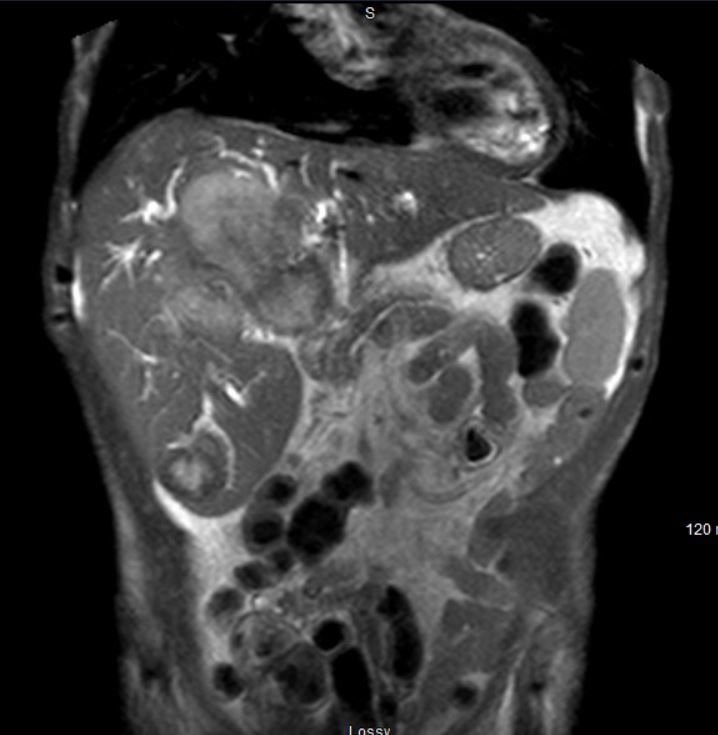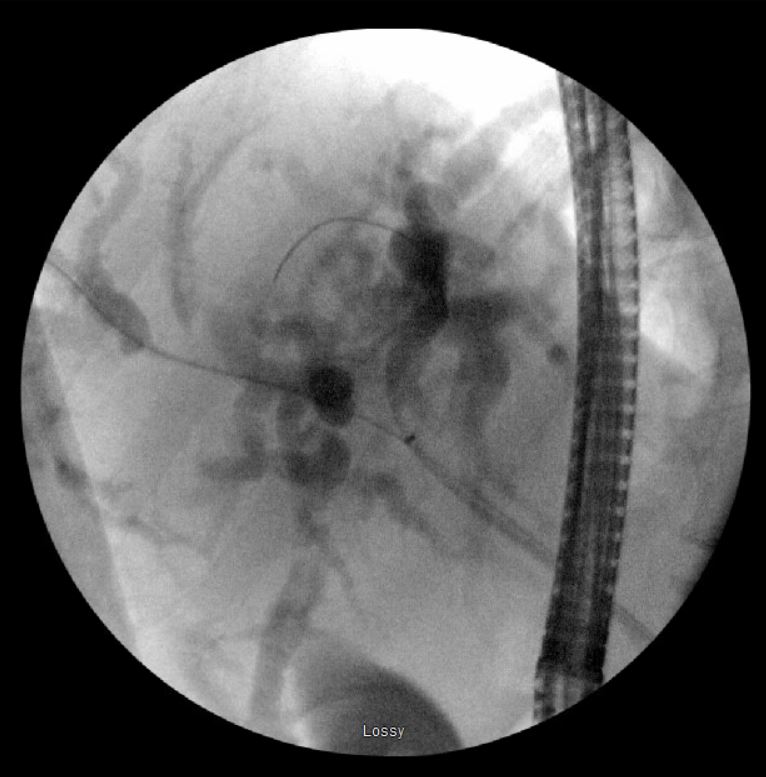Tuesday Poster Session
Category: Liver
P6083 - Obstructive Jaundice Secondary to Primary Epithelioid Hemangioendothelioma
Tuesday, October 28, 2025
10:30 AM - 4:00 PM PDT
Location: Exhibit Hall
- DP
Deep Patel, BS, MD
University of South Florida Health
Valrico, FL
Presenting Author(s)
Deep Patel, BS, MD1, Pratik Patel, MD2, Jonathan Hilal, MD3
1University of South Florida Health, Valrico, FL; 2USF Health, Tampa, FL; 3Tampa General Hospital / University of South Florida, Tampa, FL
Introduction: Epithelioid Hemangioendothelioma (EHE) is an exceptionally rare vascular endothelial cell tumor, with a reported incidence of approximately 1 case per 1 million people. EHE can present in any organ system and is metastatic in ~ 50% of cases. Clinical presentation varies, often leading to misdiagnosis and delay in management. We present a rare case of obstructive jaundice secondary to primary hepatic EHE.
Case Description/
Methods: 69-year-old male initially presented to an outside facility for a fall. Workup was significant for total bilirubin of 15.8, CA 19-9 of 4000, and a normal Alpha-fetoprotein (AFP) and Carcinoembryonic Antigen (CEA). MRI Abdomen revealed a liver mass measuring approximately 11x7x 9 cm centered in segment IVb with heterogeneous T2 signal and heterogeneous peripheral enhancement resulting in obstruction of the intrahepatic biliary system at the left main and right anterior/posterior ducts. Additional bilobar satellite metastases were seen (Figure 1). Percutaneous biopsy revealed tumor cells positive for ERG, CD31 and CAMTA1, consistent with EHE. ERCP was performed for biliary decompression with placement of bilateral plastic biliary stents (Figure 2). Total bilirubin was 8 at discharge. Per the Oncology team, the plan was for Y-90 of dominant liver mass, as he did not qualify for systemic treatment due to persistent hyperbilirubinemia. Unfortunately, he passed away prior to initiation of treatment.
Discussion: Primary Hepatic EHE is an incredibly rare malignancy that is poorly understood and has unclear treatment guidelines. Differential diagnosis includes hepatocellular carcinoma, cholangiocarcinoma, hemangioma, among others. Clinical presentation varies and can range from asymptomatic to liver failure. Characteristic MRI findings on T2 sequence include a white target-like sign, with gradual peripheral ring like enhancement that results from vascular infiltration of hepatic sinusoids and small vessels. Histologic features include epithelial-like and dendritic cells that express CD31, CD34, CD12, vimentin and Factor VIII antigen. Research in EHE management is limited, and current treatment options include anti-angiogenesis medications, chemotherapy, radiotherapy, surgical resection and liver transplantation (LT). Overall prognosis is favorable compared to other liver tumors. Unfortunately, older age and masses >10cm, as in our patient, are poor prognostic factors. Further research may help with the development of targeted therapies to potentially improve outcomes.

Figure: Bilobar satellite metastatic lesions.

Figure: Placement of bilateral plastic biliary stents for biliary decompression via ERCP.
Disclosures:
Deep Patel indicated no relevant financial relationships.
Pratik Patel indicated no relevant financial relationships.
Jonathan Hilal indicated no relevant financial relationships.
Deep Patel, BS, MD1, Pratik Patel, MD2, Jonathan Hilal, MD3. P6083 - Obstructive Jaundice Secondary to Primary Epithelioid Hemangioendothelioma, ACG 2025 Annual Scientific Meeting Abstracts. Phoenix, AZ: American College of Gastroenterology.
1University of South Florida Health, Valrico, FL; 2USF Health, Tampa, FL; 3Tampa General Hospital / University of South Florida, Tampa, FL
Introduction: Epithelioid Hemangioendothelioma (EHE) is an exceptionally rare vascular endothelial cell tumor, with a reported incidence of approximately 1 case per 1 million people. EHE can present in any organ system and is metastatic in ~ 50% of cases. Clinical presentation varies, often leading to misdiagnosis and delay in management. We present a rare case of obstructive jaundice secondary to primary hepatic EHE.
Case Description/
Methods: 69-year-old male initially presented to an outside facility for a fall. Workup was significant for total bilirubin of 15.8, CA 19-9 of 4000, and a normal Alpha-fetoprotein (AFP) and Carcinoembryonic Antigen (CEA). MRI Abdomen revealed a liver mass measuring approximately 11x7x 9 cm centered in segment IVb with heterogeneous T2 signal and heterogeneous peripheral enhancement resulting in obstruction of the intrahepatic biliary system at the left main and right anterior/posterior ducts. Additional bilobar satellite metastases were seen (Figure 1). Percutaneous biopsy revealed tumor cells positive for ERG, CD31 and CAMTA1, consistent with EHE. ERCP was performed for biliary decompression with placement of bilateral plastic biliary stents (Figure 2). Total bilirubin was 8 at discharge. Per the Oncology team, the plan was for Y-90 of dominant liver mass, as he did not qualify for systemic treatment due to persistent hyperbilirubinemia. Unfortunately, he passed away prior to initiation of treatment.
Discussion: Primary Hepatic EHE is an incredibly rare malignancy that is poorly understood and has unclear treatment guidelines. Differential diagnosis includes hepatocellular carcinoma, cholangiocarcinoma, hemangioma, among others. Clinical presentation varies and can range from asymptomatic to liver failure. Characteristic MRI findings on T2 sequence include a white target-like sign, with gradual peripheral ring like enhancement that results from vascular infiltration of hepatic sinusoids and small vessels. Histologic features include epithelial-like and dendritic cells that express CD31, CD34, CD12, vimentin and Factor VIII antigen. Research in EHE management is limited, and current treatment options include anti-angiogenesis medications, chemotherapy, radiotherapy, surgical resection and liver transplantation (LT). Overall prognosis is favorable compared to other liver tumors. Unfortunately, older age and masses >10cm, as in our patient, are poor prognostic factors. Further research may help with the development of targeted therapies to potentially improve outcomes.

Figure: Bilobar satellite metastatic lesions.

Figure: Placement of bilateral plastic biliary stents for biliary decompression via ERCP.
Disclosures:
Deep Patel indicated no relevant financial relationships.
Pratik Patel indicated no relevant financial relationships.
Jonathan Hilal indicated no relevant financial relationships.
Deep Patel, BS, MD1, Pratik Patel, MD2, Jonathan Hilal, MD3. P6083 - Obstructive Jaundice Secondary to Primary Epithelioid Hemangioendothelioma, ACG 2025 Annual Scientific Meeting Abstracts. Phoenix, AZ: American College of Gastroenterology.
